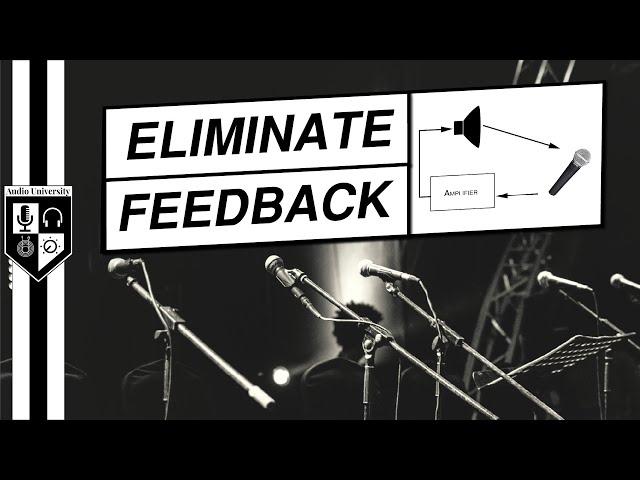
How To Eliminate Microphone Feedback | 5 Must-Know Tips
Комментарии:

Hey man... thank you for this great video! One question. What would you recommend for a congregation type setting? In our Hall, we have like 15 ceiling mounted speakers. Most of the time, there's no issues, but for some members, when they comment, instant feedback. We have to lower the volume pretty much all the way down making it hard to even hear their comment. Something about their voice tone or frequency that causes feedback, I don't know. Most of the time, it happens with the soft-spoken members. Anyway, we're using a TOA 900 series amplifier for the volume control. We're using the Shure SM58 wireless mics with a Shure BLX4R receiver. What would you recommend we do to help avoid that feedback?
Ответить
Show some practical bro
You are teaching book

big guy u are clear and really good
Ответить
I think preamp gain should be set based on what is required for a great basis for front of house mixing. Ideally you want to have all faders for FOH sound to be within -15 to +5 db area. (Exact markings depend on the mixer, some mixers mark this aforementioned 0db as -18db and then have 0 where you got horrible digital clipping, but should still portray the logarithmic scale on fader markings.)
Higher gain than necessary results in lower fader position, where even a small movement of fader is a big change in sound level. And lower gain than necessary will cause you to run out of the fader travel without getting enough sound level. And on a multichannel pre-fader multimonitor setup you better not touch the gain after you have set it, no time to compensate everything down the line in a live setting.
There is a simple trick to get the monitor levels to be at unity if you want to have that: turn down the monitor amp volume control, set the monitor sends, and then turn the monitor volume slowly back up where it is needed.

Hello
Ответить
I liked tip#3 because its very specific haha I usually just pulled all the frequencies on my geq by 6
Ответить
Good day sir kindly I would you to help learn how to set sound from begining . I have no knowledge of sound system.
Ответить
Are you suggesting attenuating the input gain of each channel on a main mixer according to the maximum monitoring levels on stage, or for the situation you have a separate mixer for monitoring? I get the idea, but to me this wouldn't make much sense on a main mixer in terms of gain staging. Maybe I misunderstood
Ответить
Thanks for the video! I'd like to mention that gain is in everything throughout the signal path, not just the preamp gain control. I think the term could be more clear if called "maximum total amplification before feedback", meaning that it has to do with all the amplification stages the signal goes through.
Electrical noise also has to do with system feedback, so it's always good to set the preamp with the proper gain for the instrument, and letting a bunch of unnecessary noise get through by using the output levels as input levels. I agree that preamp gain has to be set properly, but that means not that too much as well as not too little. It depends on the signal level coming from the instrument, not on feedback.

Super helpful !! So helpful, in fact, I subscribed. THANK YOU.
Ответить
Great video!!
Ответить
do have can you do a video on signal to noise ratio
Ответить
How many of you have recorded at home and forgot to take the track out of record before turning up your main monitors?
(I hope it's not just me 🤦♂️)

교육영상으로 훌륭
Ответить
Because I’m usually the only person in my studio, I just simply either turn right down or Off my monitors and use IEMs when singing into the Mic just to be safe.
I’m currently using one of those Zoom H2n Recorders (just for its Microphone) and plug its Line-Out into an audio interface. I do plan on buying a regular Condenser Mic later on though because I’m really interested and want to try one out!

How do you identify the problem frequencies?
Ответить
Amazingggg
Ответить
Question . How do you connect a Behringer FBQ2496 feedback destroyer to a Behringer PMP6000 powered mixer? I am only using this for home karaoke parties. I don't have a full band equalizer to do what you taught. Only an onboard 7 band equalizer that doesn't seem to help. A detailed description of using what cables involved ie an insert Y-cable to what input of the mixer. It was not recommended to insert into the FBQ into the microphones' s insert channel per the manufacturer. Their connection diagram on the user manual doesn't seem to suit mine. I have 2-3 microphones, 3 sound sources and 2PA speakers and 2 Powered Subs. Thanks for any helpful answers.
Ответить
I have a 2 channel power amp available to connect to an Allen/Heath PA28 mixer. The user manual talks about using FB1 for monitors, which I have configured the A-B outputs where 'A' is used for monitors via one amp channel and 'B' for Mains via the other amp channel. Is this the proper way to hook up the monitors or should I be using the Aux send? I have no individual control of instruments/vocals to specific monitors but I assume that's because I'm limited to just two power channels?
Ответить
How do you know what frequency is starting to feedback and which EQ band corresponds with feedback frequency?
Ответить
Nice voice and explanation.
Ответить
I'm not sure I understand the way you gain stage... How would gain staging be different for monitors ? Aren't you aiming for -18 dBfs ?
Ответить
Exactly what i was looking answered all my question thank youbso much and im using the exact mic in ur explaintion😅
Ответить
Is cardiod polar pattern really the most popular pattern for live sound? I find supercardiod to be generally more useful.
Where a cardiod's null is a single point, a supercardiod's null is a ring, which enables you to place more than one monitor in the mic's null zone.
Also, with a cardiod, you have to angle a vocal mic at about 45 degrees from the floor to null out a monitor in front of the mic. With a supercardiod, the mic will be roughly parallel with the floor. That works much better for keeping the vocalist on axis even when the vocalist backs off of the mic. With a cardiod mic at a 45 degree angle, if the vocalist backs off, he/she is not only losing volume by increasing the distance to the mic, but also losing volume by going off axis.

I just use a feedback destroyer, just to be sure and extra safe....
Ответить
When you're cutting out frequencies on the graphic, is that just over the feed to the monitors or over everything?
Ответить
Nice Video sir.
n. IMP. Information
Thanks sir.👍👍👍

Did you forget to suggest Microphone selection? Condensor Mics feedback at much lower levels than Dynamic Mics (risky!). Another big problem is getting the singer to sing louder than the monitor speaker. A very soft singer is a tough problem.
Ответить
You are the best. Appreciation from Pakistan!
Ответить
There is something subtly wrong with your description of when feedback will occur. It is not when the amplified sound of the singers voice is louder than the singers voice, any sound that makes it to a microphone at a high enough level that when the sound captured by the microphone is be then amplified, the gain produces an amplified sound that then makes it back to a microphone at a high enough level to repeat the amplification in a loop. Feedback is always happening, the screaming of a tight band of frequencies that we call feedback is just when the feedback of any sound can built on itself getting louder and louder until it reaches the maximum volume that can be produced by the amplifiers and speakers. A system can start to audibly feedback seemingly out of the blue or when someone or something moves in a way that reflects just enough extra to trigger a loop of the system is on the edge of a feedback loop.
The more open microphones there are, the less it takes to trigger a feedback loop.

I have a limiter in my monitor chain. For problem hard to find freq’s, I drop the threshold of the limiter as low as it will go. I then raise the gain of the mic till it starts to feed back. Because of the low threshold on the limiter, the limiter will only allow it to feedback at a very low volume, not allowing it to “run away”. At this point you have immunity, and can play with the 1/3 octave, pushing faders up to see which is the problem freq, or cup the mic causing to feedback, all at a low, controlled volume. Or, view the problem freq’s on an rta. Afterward, bring the mic back to a reasonable volume before raising the threshold back up. I eventually set the threshold to just kiss the louder stuff, helping the musicians from going through too much audio fatigue, and protecting you amps and speakers. Btw, I trim my mics cold so there’s much less chance of distorting the mic pre. Remember, a distorted signal can derate your speakers handling power by as much as 90%!
Ответить
I have limiters in the monitor chain. For real problems, I drop the threshold of the limiter down very low, then raise the gain on the mic. When it feeds back, the limiter will catch it and it will feedback at a low, controlled volume. Now with relative immunity of the feedback running away and damaging your ears or speakers, you can play with the 1/3 octave to find the most sensitive bands, or if digital, see it on an rta. You can play with it, cupping it, or hold a guitar which also will affect the response. After you stabilize it, reduce the gain to normal, then raise the threshold of the limiter to where it just kisses the signal at the loudest points. A slight limit on your monitor helps everyone with audio fatigue, and helps to protect the system overall.
Ответить
Great work got some good tips Thanks
Ответить
Trying to discuss audio rationally these days is becoming as difficult as discussing politics. My advice for the new folks is to listen well. To your sound that is. If you have issues, give videos such as AU's a watch. If someone tells you 'This is the absolute and only way to approach this issue.' Just say thanks and look elsewhere. Spent 50 years in this business. From tube to solid state. From home made to $100,000 mixers. Helped engineer a gold record before leaving the studio for live and still love doing it. But I or no one is perfect. You never stop learning. If you think you know it all you'll be left behind. And in my travels I found that AU's videos are the most concise, no frills approach to achieving good sound. After all it's not just Kyle's educated opinion, he researches this stuff confiding in experts in their fields. My best advice is to always maintain a healthy positive attitude and you'll get through. Happy mixing.
Ответить
I was taught that as a guitarist everybody really wants to hear me the most.
Ответить
Thanks mate.
Ответить
GOOD TECHNICS
Ответить
Hi Kyle, I watch all your videos and I'm very grateful for them. I'm self learning live sound reinforcement and studio recording as a hobby.
Can you tell me more about your thoughts on setting the Aux to unity and then using the pre amp gain to get your level. You say that with the Aux at 0db and using the gain to regulate the level the musician needs, you can keep the gain low. This struck me as I thought gain should be set to 0db using PFL to ensure the optimal signal to noise ratio (SNR). Will your method of keeping input gain low result in a weaker signal and bring in ambient noise and then the high Aux level on the output side amplify the artist signal and the ambient noise also resulting in a degraded sound?
If there is a reason what I'm saying doesn't apply or is wrong, I'm really interested to know why, as it means I am carrying around some misconceptions or living by hard rules that don't always apply.
Thanks for all your videos and looking forward to hearing your thoughts.

10q my tech
Ответить
if you set your monitor send and channel send at unity then add preamp gain to desired loudness you are changing the preamp gain in the front of house. not having tried this method, my immediate concern would be improper gain at front of house (too low, too high). I have always dialed in preamp gain with the FOH. then while running monitor at unity i'll adjust the channel send to musicians needs. I typically find the musician has enough perceived loudness well before the channel send reaches unity or feedback ( given that the musician doesn't cup the mic and the stage is set up properly)
Ответить
Thank you
Ответить
LIKED & SUBSCRIBED 😆
Ответить
i wish there was some kind of dynamic eq that would cut feedback loops when detected above a threshold and then set it a little lower....so it detects sine wave at 4000 then cuts a small q automatically untill its gone ..then sets it back to 0 with a small dip. Or something like that. I used a device from Behringen a looooooong time ago but it didnt really work and sounded awefull because it just cuts the beautifull high end...shouldnt this be possible with all the latest technology? Maybe in a low latency plugin?
Ответить
Do not feedback to something wrong one.we be fool
Ответить
Very useful! Thank you!
Ответить
Well information.
Ответить
Hello and thank you for this information. I have subscribed to your channel. Do you have any advice regarding musical theater actors wearing face mics? And another question, the actors want to be able to hear themselves out of the stage monitors. Is putting vocals in stage monitors is a bad idea? Where’s the best place to put these monitors? THANKS FOR ANY ADVICE!
Ответить
With many years of audio reinforcement I glean the review of the basics. It's great to think in it's most fundamental cause. Sometimes it's hard in the middle of a feedback event. In ears save 95% of feedback occurrences. Loving in ears finally becoming common
Ответить

























